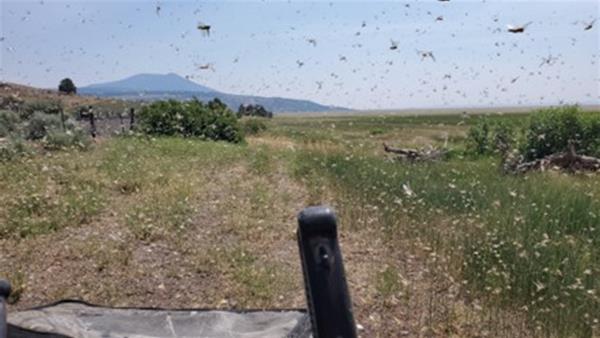
Dawn H. Gouge1, Tom J. Getts2, Tim W. Stock3, John F. Connett4, & Micah Gay1
1Department of Entomology, University of Arizona;2Cooperative Extension, University of California; 3Horticulture, Oregon State University; 4Entomology-ESM, University of Wyoming

Why all the grasshoppers?
In the western states we have over four hundred species of native grasshoppers; most causing little or no trouble to residents living in towns, cities, or rural communities. But about a dozen species are known for their population explosions. As spring progresses into summer some species are attracted by irrigated landscape plants and residential lights during nighttime flights and move in large numbers into towns.
Over the past several years high populations of grasshoppers have been noted in western states. In 2019 grasshoppers in Nevada were so numerous they appeared on weather radar and muted the lights down the Las Vegas Strip. Researchers estimated the numbers to be nearly 46 million by July, just in the Las Vegas area. In the same year high populations of pest grasshoppers were reported in some towns, as well as cropping and rangeland areas in Wyoming and Montana.
In 2022, Californian farmers reported high populations of grasshoppers in agricultural fields. University of California weed ecologist and cropping systems advisor Tom Getts confirmed “An unusually high number of grasshoppers in various intermountain valleys during the 2021-2022 growing seasons and California producers reported dense populations of about 100 per square foot of ¼ inch length nymphs in fields where female grasshoppers deposited egg pods the prior year. In less than two months they were mature adults, and still present in high densities up to 60 grasshoppers per square yard in some places”. Tom further explains, “Once full grown, the adults were dense enough to mow down fields of certain crops, and high numbers impacted growers in Oregon as well as California (Figure 1 and 2).

Figure 1. Clear-winged grasshopper females deposit multiple egg pods, containing 8-30 eggs per pod. Most species survive the winter (overwinter) in the egg stage (left), or as young nymphs (right). Many species emerge from egg pods May through June and the nymphs must feed rapidly to survive. Cool and rainy weather during this phase prevents the nymphs from feeding, causing starvation and death.
Photos: Tom Getts, University of California.

Figure 2. Clear-winged grasshoppers, 2022. Photo: Tom Getts, University of California.
Estimates on how much plant material grasshoppers can eat varies by species and stage, but daily amounts of dry weight consumption published indicates grasshoppers are able to consume between 30 and 250% of their own body weight. Scientists note that the amount of plant material consumed by a single 1250 lb cow in a day is between 19 to 31 lb, and a group of grasshoppers weighing between 8 and 104 lb can eat the same amount (Campbell, Reece, Hein 2006 https://extensionpublications.unl.edu/assets/pdf/g1630.pdf).
Because of the immense potential for agricultural impact grasshopper populations are tracked and reported in the form of USDA survey maps. Prior year summer adult populations are used to predict likely spring populations, given favorable environmental conditions (Figure 3).

Figure 3. 2022 Western U.S. Adult and Nymphal Grasshopper Survey Maps - USDA-APHIS-PPQ Western Region (please note, the grasshopper surveys do not include California).
Climate change trends towards milder and dryer winter months favor the survival of grasshoppers, with arid regions of the western states at the highest risk.
Currently, parts of Arizona are experiencing high numbers of the pallidwinged grasshopper (Trimerotropis pallidipennis Figure 4). This is a species native to western states with a range from southwestern Canada, down through the desert southwest U.S., Mexico, and into Argentina.

Figure 4. Pallidwinged grasshopper (Trimerotropis pallidipennis) adult. Photo: Paul Langlois, Museum Collections: Orthoptera, USDA APHIS PPQ, Bugwood.org. Creative Commons License licensed under a Creative Commons Attribution-Noncommercial 3.0 License.
The pallidwinged grasshopper is a large and commonly encountered grasshopper species that moves into towns to some extent each spring. The grasshoppers feed on shrubs, herbaceous flowering plants, and grasses depending upon what food plants are available. They will feed on cultivated crops including vegetables, alfalfa, mile, barley, cotton, and corn. Eggs laid the previous year hatch in early spring and the young hoppers feed on annual grasses initially, switching later to green perennial grasses, and the many rapidly germinating spring plants that carpet the desert with color after spring rain.
In the low desert regions of Arizona, nymphs develop rapidly from February through April, and adults are often noticed moving into towns in April or May. In Colorado, Utah, Wyoming, and Montana they develop into adults later in the year and are noticed in city locations in early June. In west-central Utah, hatching begins in April, and adults are seen approximately six weeks later. Similarly, hatching occurs in late April in southeastern Colorado and in eastern Wyoming. In south-central Arizona a second generation begins to hatch in June, but in higher elevation locations and in the northern states of Colorado, Utah, and Wyoming there is only one generation each year.
The grasshoppers prefer specific desert plants to feed on, but once they are depleted the grasshoppers start feeding on a greater variety of plant species. Pallidwinged grasshoppers are strong flyers, which enables them to disperse widely as desert vegetation senesces (stress-induced and age-related developmental aging) and dries out. Adults are capable of sustained flight of over 15 minutes and have been reported by aircraft pilots flying in swarms at altitudes of 3,000 to 5,000 feet.
In towns and cities pallidwinged grasshoppers find supportive conditions in areas with bare or rocky ground and weedy vacant lots where they can go unnoticed unless they are disturbed and fly (Figure 5).

Figure 5. Pallidwinged grasshoppers blending into urban landscapes.
Photo: Dawn H. Gouge, University of Arizona.
Grasshoppers play an important role in the natural environment. Numerous birds (Figure 6), including several declining species, feed on grasshoppers, as do many mammals, reptiles, and predatory invertebrates. They are a part of the natural process that affects plant composition, nitrogen recycling and other elements of soil fertility. In the urban environment they still provide many of the same ecosystem services.
Our recommendation to residents and facility managers who find their landscaping temporarily inundated by these harmless insects is to simply enjoy observing the creatures, taking a minute to marvel at their amazing jumping and flying ability.

Figure 6. A red-tailed hawk snacks on a grasshopper. Photo: Adobe Stock.
Grasshopper information resources: http://www.uwyo.edu/entomology/grasshoppers/field-guide/trpa.html
A Guide to Grasshopper Control on Rangeland https://extensionpublications.unl.edu/assets/pdf/g1630.pdf
Pallidwinged Grasshopper - Wyoming Agricultural Experiment Station Bulletin 912 Species Fact Sheet February 2002 http://www.uwyo.edu/entomology/grasshoppers/field-guide/trpa.html

The Border Tick and Rickettsia Surveillance (BiTeRS) program of the Pacific Southwest Center of Excellence in Vector-Borne Diseases (PacVec) offers services to enhance surveillance for ticks and tick-borne pathogens of human health concern in California and Arizona. This is made possible through our project leaders at the University of California, Davis, and the University of Arizona, and collaborating local and state agencies, including the California Department of Public Health and the Arizona Department of Health Services.
We help every step of the way, and identification and pathogen testing are FREE. Collection supplies and protocols are provided, and partners receive all results on ticks they have submitted.
We work with partner organizations to:Partner organizations may be:
Download the BiTeRS Flyer for distribution: https://pacvec.us/biters/


Answer: This is a male Carpenter Bee Xylocopa sp.
Congratulations to Master Insect Identification Detectives:
Patrice Kennedy, Tim Barrett, Grand Canyon University
Paula Putao, Karen Austermiller, Yavapai County Master Gardeners

If you know the answer, email Dawn at dhgouge@arizona.edu. You will not win anything if you are correct, but you will be listed as a “Master Pest Detective” in the next newsletter issue.
Upcoming Events
What’s Bugging You? First Friday Events (Host: New York State IPM Program)
Fridays | 12:00 pm. – 12:30 p.m. EDT | Zoom | Free; registration required
The first Friday of each month, spend half an hour over lunch learning about practical solutions for pest problems with the New York State IPM Program. Each presentation will end with an IPM Minute. https://nysipm.cornell.edu/whats-bugging-you/first-friday-events/
____________________________________________________________
Urban and Community IPM Webinars (Host: University of California)
UC Statewide IPM Program Urban and Community webinar series is held the third Thursday of every month to teach about pest identification, prevention and management around the home and garden. This series is free but advanced registration is required. Dates and topics below, all begin at noon Pacific. https://ucanr.edu/sites/ucipm-community-webinars/
____________________________________________________________
EPA Webinars about Integrated Pest Management
The EPA Center of Integrated Pest Management hosts a webinar series featuring national experts from across the country relaying educational and practical strategies for establishing and improving integrated pest management programs in buildings. We invite you to review the information on the past topics. Register for new or review archived IPM webinars Upcoming Integrated Pest Management Webinars | US EPA
____________________________________________________________
IPM in Multifamily Housing (Host: Stop Pests in Housing)
The IPM in Multifamily Housing Course is offered to help housing professionals provide safe and effective pest control in their communities. Advanced registration is required. Dates and topics below, all begin at 10 a.m. Pacific. Register at Webinar Registration - Zoom.
View recordings of previous EPA Integrated Pest Management Webinars at https://www.epa.gov/managing-pests-schools/upcoming-integrated-pest-management-webinars.
For more information about the EPA Schools program: http://www.epa.gov/schools/.
To view all our previous newsletters, visit: https://acis.cals.arizona.edu/community-ipm/home-and-school-ipm-newsletters.
Acknowledgements
This material is in part funded by the National Institute of Food and Agriculture, U.S. Department of Agriculture, under award number 2021-70006-35385 that provides Extension IPM funding to the University of Arizona. It is funded in part by the USDA National Institute of Food and Agriculture through the Western Integrated Pest Management Center, grant number 2018-70006-28881. Additional support is provided by the UA Arizona Pest Management Center and Department of Entomology. Any opinions, findings, conclusions, or recommendations expressed in this publication are those of the authors and do not necessarily reflect the views of the U.S. Department of Agriculture or those of other funders.
We respectfully acknowledge the University of Arizona is on the land and territories of Indigenous peoples. Today, Arizona is home to 22 federally recognized tribes, with Tucson being home to the O’odham and the Yaqui. Committed to diversity and inclusion, the University strives to build sustainable relationships with sovereign Native Nations and Indigenous communities through education offerings, partnerships, and community service.